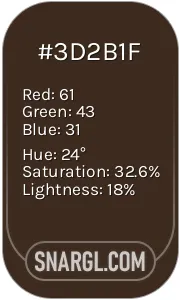
Ant
Where does the Ant live?
Ground Nests: Many ants live in nests underground. The ants construct these nests using dirt, creating a complex network of tunnels.
Mounds Above Ground: Some ant species build mounds above the ground. These mounds are made of twigs, sand, or gravel. They provide shelter and protection for the colony.
Foraging on Trees: Ants may forage on trees, especially in search of food. They explore leaves, branches, and bark, looking for insects, nectar, or other resources.
Inside Trees: Certain ant species nest inside trees. They create galleries within the wood, utilizing hollow spaces or existing cavities. These tree-dwelling ants play essential roles in forest ecosystems.
Human Habitats: Ants can also establish nests inside human structures. They may be found inside walls, voids, baseboards, and countertops. When ants invade homes, they often seek out food sources and create satellite colonies indoors.
Example of the color palette for the image of Ant

See these colors in NCS, PANTONE, RAL palettes...
What does the Ant look like?
Ants are social animals that live in colonies with different castes, such as workers, soldiers, queens, and males.
They can be found in almost every part of the world, except Antarctica and some islands.
Ants have many adaptations that help them survive and communicate in their environment.
Some of these are:
Ants have a large head and a slender, oval abdomen that are connected by a thin waist.
The waist has one or two projections called nodes that help to bend the body.
They have six legs, each with a claw and a sticky pad that allow them to grip surfaces.
Ants have two pairs of wings, but only the reproductive ants use them to fly during mating flights.
The wings are shed after mating.Ants have two pairs of jaws: the outer pair is used for carrying objects, such as food and soil, and for digging tunnels.
The inner pair is used for chewing and grinding food.
They have a long, tubular mouthpart called a proboscis that they use to suck liquid food, such as nectar and honeydew.
Ants also have a pair of glands near the mouth that produce saliva, which helps to digest food and to glue soil particles together when building nests.Ants have two antennae that are bent at an angle.
The antennae are used for sensing smells, sounds, vibrations, and touch.
Ants use their antennae to communicate with each other by exchanging chemical signals called pheromones.
Pheromones can convey information about food sources, danger, colony identity, and reproductive status.
Ants also use their antennae to groom themselves and their nestmates.Ants have compound eyes that are made of many lenses.
The eyes can detect movement, shape, and color, but they have poor resolution.
They rely more on their antennae than their eyes for navigation and recognition.
Some ants have simple eyes, or ocelli, on the top of their head that can sense light intensity and direction.
Ants use the sun and the earth's magnetic field as compasses to orient themselves.Ants have a sting at the tip of their abdomen that they use for defense and hunting.
The sting injects venom that can cause pain, swelling, and allergic reactions in humans and other animals.
Some ants, such as fire ants, can sting multiple times.
Other ants, such as bulldog ants, have a powerful bite that can pierce the skin.
Some ants, such as army ants, have large mandibles that can cut and tear flesh.
They cooperate and compete with each other, and with other organisms, in their ecosystem.
Ants are also important for the environment, as they recycle organic matter, disperse seeds, pollinate plants, and control pests.
Ants are one of the most successful and diverse groups of insects on Earth.
Example of the color palette for the image of Ant

See these colors in NCS, PANTONE, RAL palettes...
Example of the color palette for the image of Ant

See these colors in NCS, PANTONE, RAL palettes...
Daisy and the Legend of the Pea Pod Rise
One warm summer morning, as the sun cast a golden glow over the fields, the village was abuzz with excitement over a mysterious prophecy. According to an old legend, a magical pea pod hidden deep within the village's ancient garden had the power to bring prosperity and joy to all who found it. The legend spoke of the "Rise of the Pea Pod," a wondrous event that would unfold when the pea pod was discovered.

The prophecy also mentioned that the pea pod's rise could only be achieved with the help of a truly dedicated seeker and their loyal companion. Naturally, Sequoia and Daisy, both known for their curiosity and adventurous spirit, took it upon themselves to solve the mystery.
Their quest began in the ancient garden, a place overgrown with lush greenery and blooming flowers. The garden was said to be enchanted, with pathways that shifted and secret places that only revealed themselves to those with genuine intent. As they entered the garden, Daisy scurried ahead, her tiny legs a blur as she explored every nook and cranny. Sequoia followed, her keen eyes scanning for clues.
Their first challenge came in the form of a puzzling labyrinth of hedges. Daisy, ever the enthusiastic explorer, dashed into the maze, only to find herself quickly turned around by the twisting pathways. Sequoia, observing Daisy's predicament with a chuckle, decided to take a different approach. Using her knowledge of herbal remedies, she brewed a calming potion that emitted a sweet aroma, guiding Daisy back to her.

With the maze navigated, Sequoia and Daisy found themselves at the entrance to an old greenhouse. Inside, the air was thick with the scent of blooming plants and the soft hum of magical energy. They discovered a series of enchanted puzzles hidden among the flowers and vines. Each puzzle required solving riddles and arranging magical stones to reveal hidden compartments.
Daisy, despite her tiny size, proved invaluable with her meticulous attention to detail. She scurried around, examining each riddle with great care and helping Sequoia place the stones in the correct order. Their teamwork was flawless, and soon enough, the final compartment revealed a small, ornate chest.
Inside the chest lay a single, shimmering pea pod, its surface sparkling with a mystical glow. Sequoia and Daisy marveled at their find. The pea pod's magical energy seemed to pulse with warmth and happiness, a true testament to the legend's promise.

As they held the pea pod up, the garden around them began to change. Flowers bloomed in radiant colors, and the air was filled with the joyous sounds of the village's celebrations. The prophecy had come true - the pea pod's rise had brought a wave of prosperity and delight to Verdant Grove.
The legend of Daisy and the Pea Pod Rise quickly became a cherished story in Verdant Grove. It was a tale of courage, curiosity, and the unbreakable bond between a dedicated seeker and her loving ant companion. The story was often recounted with laughter and fondness, highlighting how even the smallest of heroes could achieve great things with a bit of determination and a lot of heart.
Sequoia and Daisy continued their adventures, their reputation as the village's favorite duo growing with each new tale. Their legend served as a reminder that magic and joy could be found in the most unexpected places, and that the greatest achievements often came from the simplest acts of love and friendship.



 Dark brown
Dark brown Dark tan
Dark tan Olive Green
Olive Green Umber
Umber Bistre
Bistre




 Smoky black
Smoky black Dark olive
Dark olive Khaki
Khaki Light goldenrod yellow
Light goldenrod yellow Android Green
Android Green Dark green
Dark green Turquoise
Turquoise Mountain Meadow
Mountain Meadow Hooker green
Hooker green Pine Green
Pine Green





